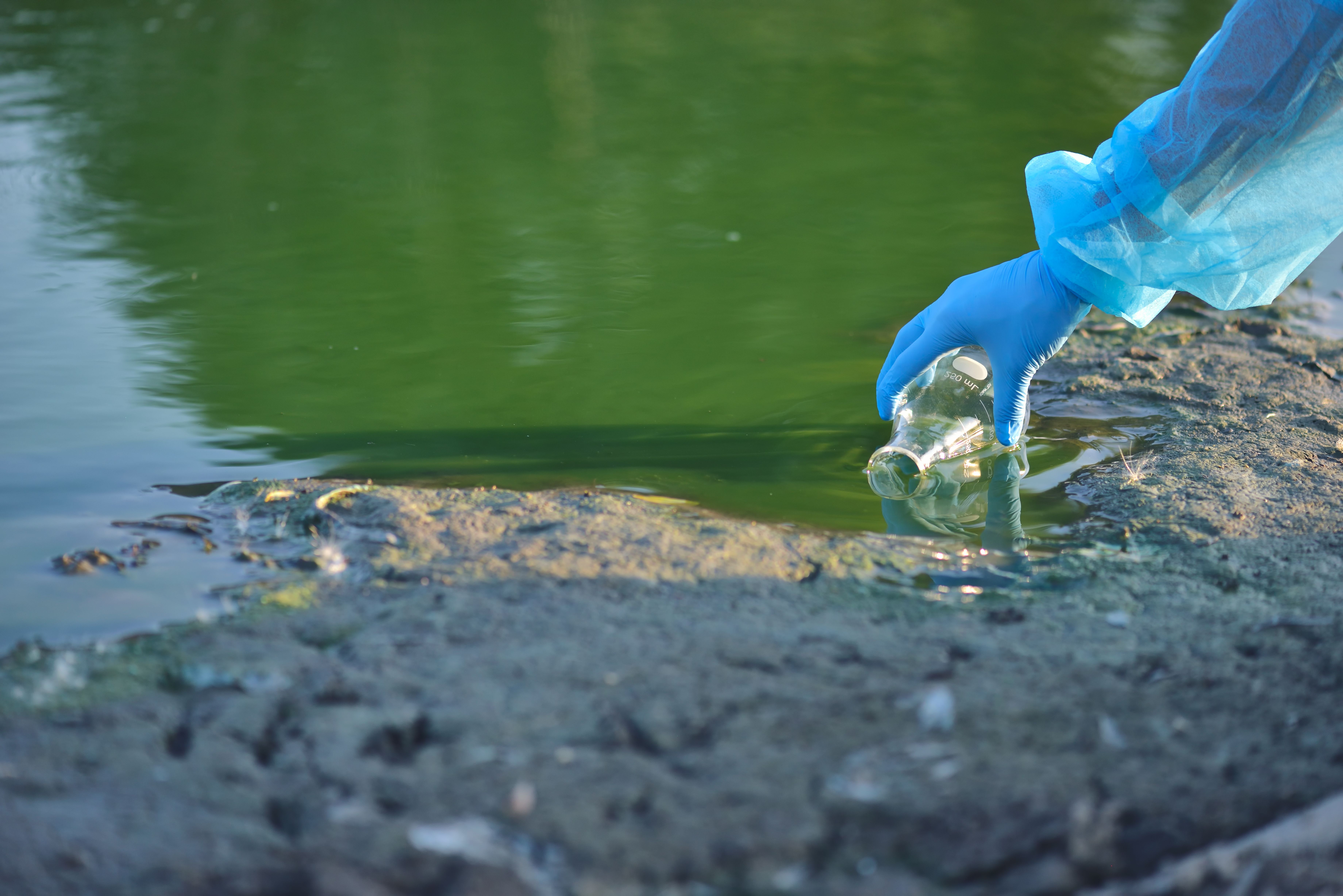GC✕GC–TOF-MS Helps Quantify Pesticides in Water Susceptible to Contamination
Pesticides in local surface and groundwaters were purified and enriched with solid-phase extraction, then analyzed using multidimensional gas chromatography coupled to mass spectrometry, with the results compared to those found by gas chromatography–quadrupole mass spectrometry.
A team led by Flavio A. Franchina at the University of Ferrara in Ferrara, Italy, has demonstrated multidimensional gas chromatography coupled to mass spectrometry (GC✕GC–MS) to quantify 53 pesticides found in surface water and groundwater in susceptible agricultural areas (1).
Close-up environmentalist hand of a researcher in a process of taking a sample of contaminated water from a lake | Image Credit: © Daniel CHETRONI - stock.adobe.com

The research, published in the journal Analytical and Bioanalytical Chemistry, sought to improve upon the traditional gas chromatography–quadrupole mass spectrometry (GC–QMS) method for pesticide analysis by combining GC✕GC with time-of-flight mass spectrometry (TOF-MS). Prior to the GC✕GC–TOF-MS analysis, the pesticides were purified and enriched using solid-phase extraction (SPE).
GC✕GC–TOF-MS has been shown to be quite useful for pesticide analysis. It is capable of separating and identifying hundreds of pesticides present in a sample with high sensitivity and accuracy. The first dimension of the GC separates compounds based on their boiling points, while the second dimension separates them based on their polarity. This provides a more comprehensive separation of complex mixtures and improves the detection of low-level compounds. The mass spectrometer then detects and identifies each separated compound based on its mass-to-charge ratio, providing information on the identity and quantity of each pesticide in the sample.
Regulations such as the Groundwater Directive, Drinking Water Directive, and Water Framework Directive set a maximum concentration of 0.1 µg/L for pesticides and their degradation products and 0.5 µg/L for total pesticide residues in a sample. In this study, GC✕GC–TOF-MS validated 14 pesticides in addition to the 39 that were previously monitored by using one-dimensional gas chromatography (1D-GC).
In a direct comparison between GC–QMS and GC✕GC–TOF-MS results for 34 real-world samples, GC✕GC–TOF-MS yielded higher sensitivity (eightfold on limit of quantification values), faster analysis time (by 40%), and a posteriori verification of the presence of pesticides not yet regulated in environmental samples. Seven of these 34 samples were in groundwaters, with the remaining 27 in surface waters. Groundwater is less prone to pesticide contamination, with an average concentration of 0.076 μg/L in samples compared to 0.298 μg/L for surface water.
Compared to GC✕GC–TOF-MS, overestimation of over ± 20% error using GC–QMS was found in 54 positive cases (48% of total), which the study attributed to the ability of GC✕GC–TOF-MS to detect quantifiable pesticides at lower concentrations. Overestimation error in GC-QMS analysis occurs when the analytical method used overestimates the concentration of a compound in a sample. This can happen due to the presence of interfering compounds that are co-eluted with the compound of interest, ion suppression or enhancement effects during ionization, incorrect calibration of the instrument, or poor quality of the sample. Overestimation can lead to inaccurate results and affect the interpretation of data, which can have serious consequences in environmental monitoring.
While there are 1,331 types of pesticides in existence according to a 2019 European Commission estimate, only 463 types have been approved for use with another 48 under review, leaving 667 that have not been approved. The impact of pesticides on human health and the environment is amplified in developing countries, the researchers said, because the chemicals used may be unpatented, cheaper, and more toxic. The non-targeted nature of GC✕GC–TOF-MS not only allowed for the detection of unregulated pesticides, but also led the team to surmise the methodology could be used to find these pesticides in air and soil as well as water.
Regarding SPE, the researchers said because sample preparation was not explored in detail in this study, future research will better develop and miniaturize sample extraction techniques.
Reference
(1) Romagnoli, M.; Scarparo, A.; Catani, M.; Giannì, B.; Pasti, L.; Cavazzini, A.; Franchina, F.A. Development and validation of a GC ✕ GC-ToFMS method for the quantification of pesticides in environmental waters. Anal. Bioanal. Chem. 2023. DOI: 10.1007/s00216-023-04686-8
Study Examines Impact of Zwitterionic Liquid Structures on Volatile Carboxylic Acid Separation in GC
March 28th 2025Iowa State University researchers evaluated imidazolium-based ZILs with sulfonate and triflimide anions to understand the influence of ZILs’ chemical structures on polar analyte separation.
Study Explores Thin-Film Extraction of Biogenic Amines via HPLC-MS/MS
March 27th 2025Scientists from Tabriz University and the University of Tabriz explored cellulose acetate-UiO-66-COOH as an affordable coating sorbent for thin film extraction of biogenic amines from cheese and alcohol-free beverages using HPLC-MS/MS.
Quantifying Microplastics in Meconium Samples Using Pyrolysis–GC-MS
March 26th 2025Using pyrolysis-gas chromatography and mass spectrometry, scientists from Fudan University and the Putuo District Center for Disease Control and Prevention detected and quantified microplastics in newborn stool samples.








